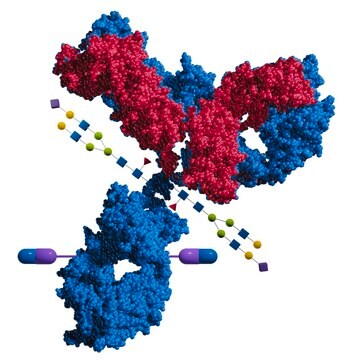MABC530
Anti-CEP Antibody, clone Das-1 (7E12H12)
clone 7E12H12, from mouse
Sinónimos:
Colon epithelial protein, CEP, Das-1 protein
About This Item
Productos recomendados
biological source
mouse
Quality Level
antibody form
affinity purified immunoglobulin
antibody product type
primary antibodies
clone
7E12H12, monoclonal
species reactivity
human
technique(s)
ELISA: suitable
dot blot: suitable
immunohistochemistry: suitable (paraffin)
immunoprecipitation (IP): suitable
western blot: suitable
isotype
IgMκ
shipped in
wet ice
target post-translational modification
unmodified
General description
Specificity
Immunogen
Application
Western Blotting Analysis: A representative lot detected elevated CEP (colon epithial specific protein) levels among intraductal papillary mucinous neoplasm (IPMN) patients samples with high-risk/malignant lesions (Das, K.K., et al. (2014). Gut. 63(10):1626-1634).
Western Blotting Analysis: A representative lot detected CEP in colon adenocarcinoma cell line LS180 and in isolated colon epithelial cells, as well as in LS-180 culture supernatant, but not in normal jejunal epithelial cells (Kesari, K.V., et al. (1999). Clin. Exp. Immunol. 118(2):219-227).
Immunoprecipitation Analysis: A representative lot co-immuoprecipitated tropomyosin 5 with CEP from the culture supernatant of human adenocarcinoma cell line LS180 (Kesari, K.V., et al. (1999). Clin. Exp. Immunol. 118(2):219-227).
ELISA Analysis: A representative lot was used as the capture antibody in combination with the isotype switched mAb Das-1 IgG as the detection antibody using purified CEP and cyst fluid samples from Intraductal papillary mucinous neoplasm (IPMN) patients (Das, K.K., et al. (2014). Gut. 63(10):1626-1634).
Immunohistochemistry Analysis: A representative lot detected significantly higher CEP (colon epithial specific protein) immunoreactivity among intraductal papillary mucinous neoplasm (IPMN) patients samples with high-risk/malignant lesions (Das, K.K., et al. (2014). Gut. 63(10):1626-1634).
Immunohistochemistry Analysis: Representative lots detected CEP (colon epithial specific protein) immunoreactivity by both fluorescent and non-fluorescent immunhistochemistry in colonic, but not small intestinal, enterocytes using both frozen and formalin-fixed, paraffin-embedded tissue sections (Moriichi, K., et al. (2009). Int. J. Cancer. 124(6):1263-1269; Piazuelo, M.B., et al. (2004). Mod. Pathol. 17(1):62-74; MIrza, Z.K., et al. (2003). Gut. 52(6):807-812; Glickman, (2001). J.N., et al. Am J Surg Pathol. 25(1):87-94; Griffel, L.H., et al. (2000). Dig. Dis. Sci. 45(1):40-48; Hamilton, M.I., et al. (1995). Clin. Exp. Immunol. 99(3):404-411; Halstensen, T. S., et al. (1993). Gut. 34(5):650-657; Das, K.M., et al. (1987). J. Immunol. Vol. 139(1):77-84).
Dot Blot Analysis: A representative lot detected CEP immunoreactivity in colon protein extracts (Hamilton, M.I., et al. (1995). Clin. Exp. Immunol. 99(3):404-411).
Quality
Immunohistochemistry Analysis: A 1:1,000 dilution of this antibody detected CEP in human colon tissue.
Target description
Physical form
Other Notes
¿No encuentra el producto adecuado?
Pruebe nuestro Herramienta de selección de productos.
Storage Class
10 - Combustible liquids
wgk_germany
WGK 2
flash_point_f
Not applicable
flash_point_c
Not applicable
Certificados de análisis (COA)
Busque Certificados de análisis (COA) introduciendo el número de lote del producto. Los números de lote se encuentran en la etiqueta del producto después de las palabras «Lot» o «Batch»
¿Ya tiene este producto?
Encuentre la documentación para los productos que ha comprado recientemente en la Biblioteca de documentos.
Nuestro equipo de científicos tiene experiencia en todas las áreas de investigación: Ciencias de la vida, Ciencia de los materiales, Síntesis química, Cromatografía, Analítica y muchas otras.
Póngase en contacto con el Servicio técnico






